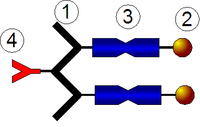
Photo from wikipedia
Native chemical ligation (NCL) provides a powerful solution to assemble proteins with precise chemical features, which enables a detailed investigation of the protein structure-function relationship. As an extension to NCL,… Click to show full abstract
Native chemical ligation (NCL) provides a powerful solution to assemble proteins with precise chemical features, which enables a detailed investigation of the protein structure-function relationship. As an extension to NCL, the discovery of desulfurization and expressed protein ligation (EPL) techniques has greatly expanded the efficient access to large or challenging protein sequences via chemical ligations. Despite its superior reliability, the NCL-desulfurization protocol requires orthogonal protection strategies to allow selective desulfurization in the presence of native Cys, which is crucial to its synthetic application. In contrast to traditional thiol protecting groups, photolabile protecting groups (PPGs), which are removed upon irradiation, simplify protein assembly and therefore provide minimal perturbation to the peptide scaffold. However, current PPG strategies are mainly limited to nitro-benzyl derivatives, which are incompatible with NCL-desulfurization. Herein, we present for the first time that quinoline-based PPG for cysteine can facilitate various ligation strategies, including iterative NCL and EPL-desulfurization methods. 7-(Piperazin-1-yl)-2-(methyl)quinolinyl (PPZQ) caging of multiple cysteine residues within the protein sequence can be readily introduced via late-stage modification, while the traceless removal of PPZQ is highly efficient via photolysis in an aqueous buffer. In addition, the PPZQ group is compatible with radical desulfurization. The efficiency of this strategy has been highlighted by the synthesis of γ-synuclein and phosphorylated cystatin-S via one-pot iterative ligation and EPL-desulfurization methods. Besides, successful sextuple protection and deprotection of the expressed Interleukin-34 fragment demonstrate the great potential of this strategy in protein caging/uncaging investigations.
Journal Title: Journal of the American Chemical Society
Year Published: 2022
Link to full text (if available)
Share on Social Media: Sign Up to like & get
recommendations!